"Peel an onion. There are lots of layers." It is a common saying, and a classic symbol.
I find it to be a helpful metaphor to describe how my research developed over time on South Korean coins, an obscure topic for which there existed few easily accessible comprehensive studies or documents, either in Korean or any other language. After hitting a brick wall with my initial attempts to appeal to Korean authorities for information, I struggled on, attempting to find a single previously written work, as if groping for the edges of that first layer. The hope was that in peeling back that first layer, I could scale into ever more layers of evidence hidden beneath.
If in the review of the existing literature the researcher finds at least some previously written works, their footnotes or bibliographies can, of course, lead him to other written works, and eventually to that precious documentation that is closest to the original source. Armed with these new leads, he can then discover others, in similar fashion, and even "undiscovered" sources.
However, the leads the numismatic researcher finds are not limited to books and documents, but also take the form of his learning and using the esoteric vocabulary that is used within the field. Numismatic literature can contain such a specific vocabulary and usage that is unfamiliar to even highly educated native speakers of the language in which it is used. Korean numismatics terminology is no exception, and because of its specificity, it became a rather useful search tool during the research phase of writing my book. Other equally important leads include contacts with others who can help the researcher gather evidence and images or point him to new sources of information. All the people who helped me were incredibly generous, especially those current and former practitioners within Korea's currency industry, numismatic businesses, and among its coin hobbyists.
The very first of the leads that I hit upon allowed me to grab hold of the edges of those first layers and get going the process of delaminating the onion.
It should also be mentioned that the 'peeling of the onion' metaphor also implies that you become more involved in something as you look further into it. In my case, it resulted in fascinating reading, conversation, and learning beyond my original, narrow focus and into various other fields of study, such as contemporary Korean history, economics, and industrial processes. These broader explorations ended up shaping the final form of my book and therefore readers of my book will notice that my method exhibits a moderate integration of these various disciplines. I hope that in doing so I have not totally violated the canons of any of these fields of study, least of all numismatics!
The research for my book began with a few questions.
 |
|
Author Mark Lovmo (center) with Oh Soonhwan and Jeon Yeong-yul at the Korean Mint's Design Office. |
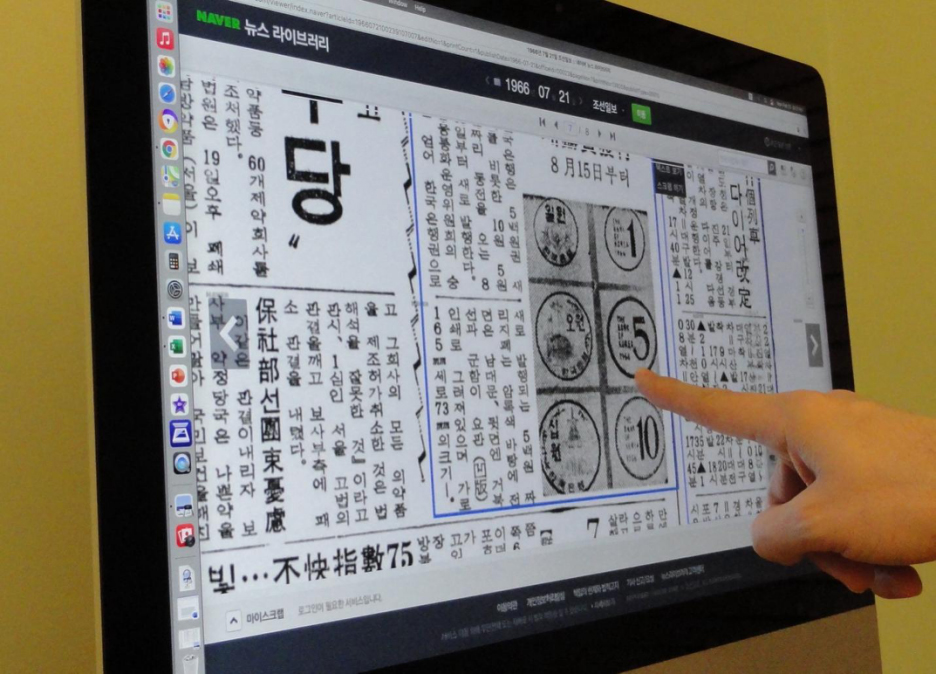 |
|
The Naver News Library is a subscription-free source had thousands of newspaper articles on Korean coins that I had to review for relevant information for my book. |
The Questions
The research project that eventually resulted in my book, South Korean Coins in the Era of Development, stemmed from an initial desire to learn a little more about South Korean coins beyond the basic specifications and mintage information found in the widely available Korean and English-language coin catalogs that I had been using since beginning my South Korean coin collection in the early 2000s.
By 2009, I had become a serious collector of these coins, to include high-grade key date business strikes, some commemoratives, and Bank of Korea mint sets. My South Korea collection grew alongside a U.S. Lincoln Cent collection that I had started a few years earlier. These two coin collections provided me with two radically different collecting and learning challenges. Other than the wider availability of almost every date in the Lincoln Cent series in most grades below Mint State, one of the biggest differences between my two very different collections was the huge amount of information that I could learn about Lincoln Cents when compared to South Korean coins.
A quick look at numismatic literature sold at large and small U.S. coin shows and online sources revealed many in-depth and mutifacted scholarly treatments on United States coins. These books and articles detailed a wide variety of information about the artists of the U.S. Mint, the production of its coins, these coins' function in the economy, histories of the people and objects appearing in their designs, controversies arising from these coins' circulation, and other interesting anecdotes.
For my South Korea collection, little of the above information was easily available, and certainly not in any language other than Korean. My research questions formed around the basic themes that are often addressed in U.S. coin literature, and ones that I found to be the most interesting and foundational:
Who were the artists responsible for creating the images on South Korean coins? What is the production history of these coins? How did these coins function as currency or as collectibles and what was the public's reaction to them? What do "insider" sources from the country's currency production industry have to say about these coins and how they came to be?
In asking these questions, I was hoping to go about collecting some basic information on these topics and then simply report on them in the form of English-language webpages at an existing website I operated. The bleak results from my initial English and Korean-language searches certainly gave me no cause to think that writing a book would be possible.
Appeals to Authorities
My first web searches resulted in almost no information outside of a handful of decades-old articles and books available from the American Numismatic Association's library that were of limited help. Therefore, I decided to go to the source.
Being a complete novice to contacting Korean authorities, I wrote several letters and emails to, what I thought were, the appropriate contacts at both the Bank of Korea and the South Korean Mint (KOMSCO) to inquire about these topics. I say "several" letters and emails, since a month or more would pass without a single response, which irked me enough to write additional appeals. I was hoping that if I barraged them with letters, they would eventually give up and respond. That would not happen, at lest during this early phase of my research.
At an impasse, I decided that I would be better served by refining my Korean-language internet searches to better target any existing references to relevant sources of information. For example, I found that using the Korean search term for "designer" (도안자 / 圖案子) in combination with terms related to coins and currency resulted in almost no relevant sources. What I had not taken into consideration was Koreans' almost wholesale adoption of English vocabulary in lieu of perfectly functional words that already existed in their own language! When I tried again using the term "디자인어" (directly transliterated from the English word, "designer") in combination with Korean currency search terms, I immediately found reference to several online Korean media reviews of a book published in 2006 on Korea's contemporary currency and coins, in addition to a table of contents from this book. The English title of the book was Korean Commemorative Coins by a former Korean Mint designer and executive, Jo Byeongsu(曺秉須/조병수). I had finally peeled back the first layer of the onion.
The First Layer
After receiving a copy of this book in the mail from Korea's venerable Kyobo Bookstore, I was a little disappointed. The author, Jo Byeongsu, did not use a single footnote or endnote to cite his primary sources, nor was there much of a bibliography beyond a handful of seemingly secondary sources. However, even with my very basic ability in Korean, a quick read allowed me to realize that this was the seminal work in the Korean language on my research topic. Things began to look up after extensive translation of this books' chapters into English further revealed just how much Mr. Jo's book was evidently littered with information from internal Korean Mint documents, some of which he referred to by their titles, and some even appeared as charts and images in the book itself.
As a practitioner within Korea's coin industry, Mr. Jo also made heavy use of the extremely rare Korean numismatic and coin industry vocabulary. Finding a wide range of this unusual Korean terminology in one book was tantamount to hitting the jackpot, research-wise. This allowed further refinement of internet search terms, and the result was not necessarily a flood of new information, but a gradual trickle of one highly useful source after another. Mr. Jo's book also made reference to certain dates and named various Korean government rulings and decisions related to coins that I could also utilize in my searches.
Among the results of these new internet searches were decades-old, and barely viewed, yet very interesting articles written by the Bank of Korea's Issue Policy Team at the Bank of Korea's website directory. Also buried within this directory were primary sources in the form of the policy resolutions of the Bank of Korea's oversight organization, the Monetary Policy Board. The website was also an official source from which to cite coin specifications and yearly mintages for the commemorative coins.
My new internet searches also resulted in finding articles from another former artist who had worked at the Korean Mint's Design Office, Oh Soonhwan(吳順煥 /오순환). Mr. Oh's articles were published on the website of South Korea's premier numismatic auction business, Poongsan Hwadong. These were yet another source of invaluable insights and anecdotes from an insider who was intimately involved in the work on several of the country's early commemorative coins and the early 1980s redesign project for the circulation coins. Hwadong's website was also a helpful tool in finding historical auction results from the sales of key date coins and coin sets during the surge in numismatic interest in Korea in the 2000s and 2010s. These and other small bits of reliable information from online Korean news sources began adding up. As the sources started to accumulate, I switched gears to writing.
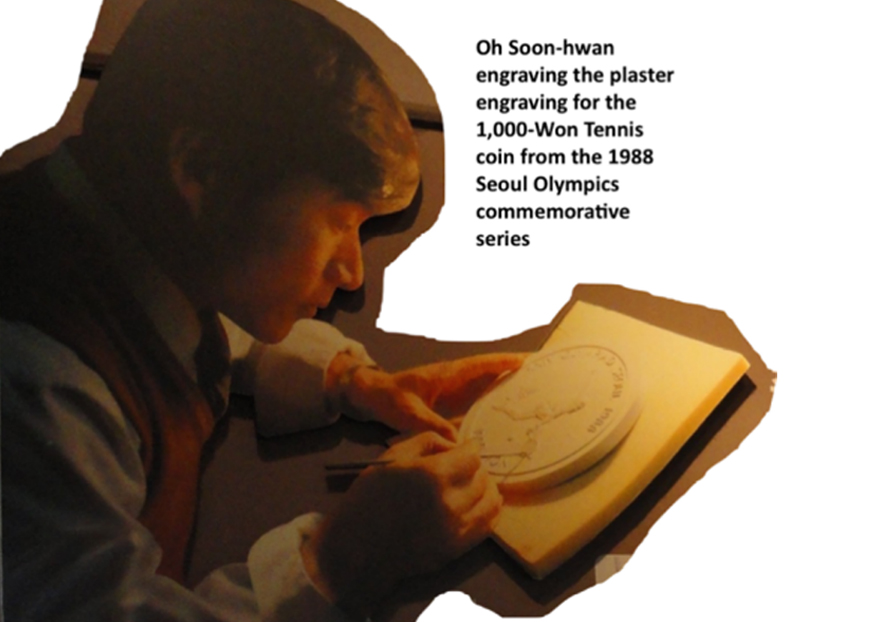 |
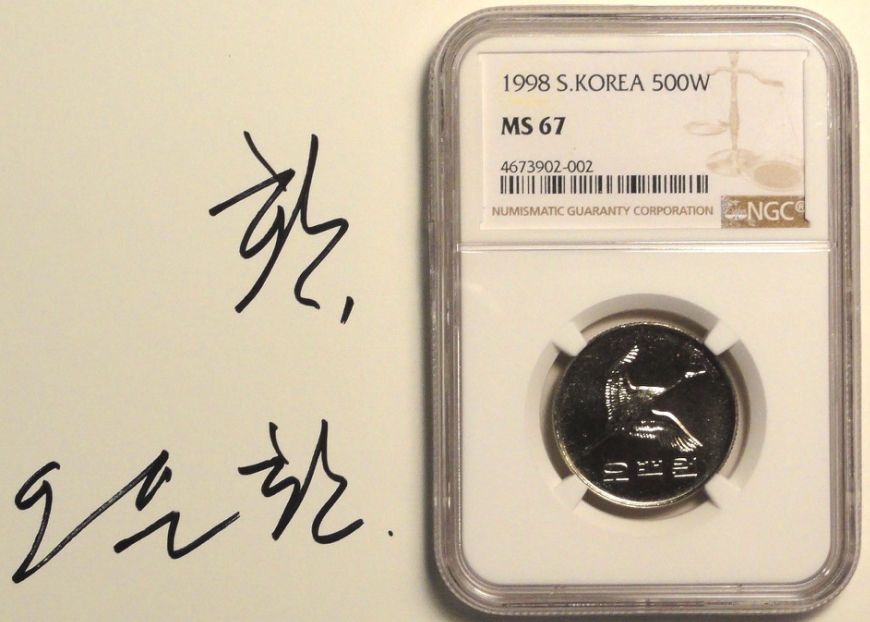 |
|
Engraver Oh Soonhwan told me that an occupational hazard for engraving artists comes from degraded eyesight after years of working on snow-white gypsum plaster models. |
I was lucky enough to convince Oh Soon-hwan, the Korean Mint artist who engraved the crane image on the 500-Won coin, to sign his name. He signed it with artistic flourish: "Hwan, Oh Soonhwan." |
Getting it Written
Sometimes the piling on of evidence merely adds to the researcher's problems as much as a lack of sources can. I needed to sort it all out and make sense of it. Planning your writing, as well as the act of writing itself, slows you down and helps with focusing on what is important as well as deciding how to present the finished work. I decided that separate narratives detailing each coin series in a webpage format decorated with images and data charts would be the most interesting presentation. I thought this would also be the best approach in satisfying both those readers who only want specifications and mintage data, and those who would like the full story behind each coin. I would work on the six circulating coins first, then attempt to tell the story of South Korea's first four (1975-1982) commemorative issues.
As I assembled and posted each of these chapters at my website, I also took occasional breaks from writing to go back to the research effort. As I did this writing in addition to being employed full-time, it took a total of five years to finish writing all the articles, ten in total, plus a chapter on Bank of Korea mint sets. In the following years, I had the luck of getting a few articles based on my internet pages published with Coin Week online in 2015 and 2017, in the print version of COINage magazine in February 2017, and later with the Journal of East Asian Numismatics (JEAN) in 2019 and 2020.
After what seemed to be a considerable amount of writing, and especially after I had gotten my hands on the more important documentation on Korean coins and coin production (see below), I was starting to believe that I had enough new sources to begin to re-write some of my coin articles yet again, but this time in the form of chapters for a book. I knew that writing a book would take a few more additional years of research and writing, and in finding a publisher, a bit of luck.
Help Arrives
During these years that I wrote each of these early versions of my research studies and posted them on my own website, I continued the alternating cycles of writing, researching, and even promoting my website at online forums to alert Korean coin hobbyists of what I had found. One of my online forum entries elicited the intense interest of a Canadian fan of Korean coins, Jonathan Powelson. and he began sharing with me published and unpublished Bank of Korea documents and files that he had begun finding buried in Korean government online archive listings. He also compiled lists of final auction results for Korean coins and coin sets at one of South Korea's most active online auction sites, Narauction, as well as pricing from several of the more active retail businesses in the country. The most helpful of the documents that Jon shared with me was a very informative official Bank of Korea source, Korean Currency after the Japanese Imperial and Liberation Eras (日帝時代 및 解放 以後 韓國의 貨幣 / 일제 시대 및 해방 이후 한국의 화폐 ). This is the 2004 version of a decennial Bank of Korea publication that is often given titles on variations of the name, Korean Currency. Jon soon also found the 1982 and 1994 issues of Korean Currency. Over the following years, Jon proved to be closest thing to a full time research assistant that I ever had, and I was very lucky to have had his enormous help.
Rare Korean Mint Sources
Despite the growing numbers of sources that I had to digest (and translate!), the paucity of available official Korean Mint sources bothered me, especially when embarking on writing a book about the coins that this Mint had produced. I went back through the bibliographies and footnotes of those sources that I had already found. Another look at a few of these books and documents revealed two references to Korean Mint publications that I had overlooked. Searches within Korean national library listings revealed that these two sources, Korea Minting and Security Printing Corporation 40-Year History (韓國造 幣公社四十年史 /한국조폐공사40년사) and The Monetary History of Korea (韓國貨幣全史/한국화폐전사), might possibly be available for viewing at Korean libraries. I quickly made inquiries at the Facebook pages of two Korean universities for research assistance in getting copies of these books. I immediately received help from two very capable Korean students who relayed to me copies of these rather dusty tomes. These two sources proved to be some of the more important sources for information on the development of South Korea's coining facilities, coin blank production, foreign contracts, and especially commemorative coin production.
Another very important source of information was the Korean newspaper archive. The newspapers were a source that I wanted to tap into after finding very little about South Korea's circulation coins in official sources. I thought that Korea's daily newspapers had certainly reported on the issue of the South Korea's new coins in the 1950s and 1960s. After a failed attempt to find newspaper articles about the issue and circulation of South Korea's coins on reel after reel of microfilm at the National Library of Korea during a visit to Seoul in 2014, I found found reference to the Naver News Library. It was in an interesting blog post that used Korean newspaper images from this source to tell the story of South Korea's 1962 currency reform. The Naver News Library had a very easy-to-use interface and contained images of almost every daily issue from the major newspapers in the capital city, Seoul, from the 1930s to the year 2000. One of the tools at this site turns the images of any of the hundreds of thousand of newspaper articles into readable Korean text, while also providing hangeul translations of the often-used Chinese character text. After figuring out the best approach to search for articles thereby using its "keyword" function-the Naver News Library provided me with more than enough information and interesting facts from past newspaper articles that covered the circulating coins in the key decades of the 20th century that were the focus of my book. This subscription-free archive helped me to slowly uncover details that had never been written about South Korean coins in any previous comprehensive work on the subject. These news articles also provided me with more depth and range of things to write about for my commemorative coin chapters as well.
At this point, I must stand witness to the power and usefulness of an open and free internet, which cannot be understated in regards to research. Although I made three research visits to Korea in these years, I conducted a good amount of the research for my book from my home in the United States. I must also acknowledge that South Korea's bureaucracies and news media produce prodigious amounts of print information that, when made openly available, are a great boon to the researcher, and are a testament to an incredibly literate Korean society.
Some Lucky Breaks
Luck plays an important role in most endeavors, and mine was no exception. As the revisions of my coin articles were taking full form, I decided to embark upon the daunting task of finding a publisher before making the final decision to publish my work in the form of a book. By chance, I got into a brief online conversation with Coin Week editor Charles Morgan in late 2018. Mr. Morgan suggested that I contact the Publisher and Editor-in-Chief of JEAN, Michael Chou, about my proposed book. Charles told me that Mr. Chou's publishing company produces important books on East Asian coins, and issues the most active journal that one can find on the subject. Fortune had smiled on my efforts thus far, but the luckiest of breaks was when I had the pleasure to speak to Michael Chou about my writing over the phone. In our conversation, he indicated a great deal of enthusiasm about the possibility of working with me on a book project with iAsure. With Michael's positive indication of getting my book into print, I was motivated to finish the research for the book with a final visit to Korea. I believed I should try to get into contact with at least one current or former practitioner in Korea's coin industry and possibly conduct an interview.
Soon after, another bit of good luck came my way when Oh Soonhwan agreed to be interviewed for the book. Oh Soonhwan is a former Korean Mint currency designer and design office director who, in his retirement, is publishing interesting numismatic articles with Poongsan Hwadong online. It all began when I noticed that Mr. Oh had uploaded his résumé in one of his articles. Among his many listed accomplishments was his incredible gold medal win at an important art festival in Italy. When I looked into this, I found reference to the medallic artworks that Korean Mint engraving artists had submitted to art journals in Italy in the 1980s and 1990s. Many of these same artists' names were also listed in the official Korean Mint literature as the artists responsible for producing South Korea's coins. One email after another led me to a Franciscan monk in Ravenna, Italy. He helpfully tracked down images of these artists' medallic works, one of which was an image of Mr. Oh's award-winning art medal. Through a convoluted set of connections on social media, I was able to message Oh Soonhwan about a possible interview. Mr. Oh immediately agreed, and he encouraged me to visit him in the Korean city of Daejeon, the location of the Currency Museum of Korea and the Headquarters of the South Korean Mint (KOMSCO).
The resulting interviews that I conducted with Oh Soonhwan in late June 2019 at the Currency Museum were not only hugely enlightening for my research purposes, but had produced the section of the book that is my personal favorite. This talk with Oh Soonhwan is the only instance that I am aware of that a numismatic writer had ever gotten an interview with a member of the Korean Mint's design and engraving staff, much less one as prolific, accomplished, and had risen as high in the leadership at the Mint as Oh Soonhwan. In our interview, Mr. Oh introduced me to Jeon Young-yul(全永律/전영율), the current general manager of the Design Research Center, which is located right next door to the museum. Mr. Jeon treated me to an incredible tour of the Korean Mint's design and engraving rooms, and before we left, gave me two incredible official Mint documents, the highly informative and more up-to-date Korea Minting and Security Printing Corporation 50-Year History (한국조 폐공사50년사) from 2001, and the glossy pictorial, 60 Year History of KOMSCO, published in 2011.
As I was visiting Korea that Summer, Michael Chou of JEAN encouraged me to join him at the offices of South Korea's premier numismatic business, Poongsan Hwadong, and meet with Hwadong President, J.C. Lee, and Hwadong's Deputy Head, Daiseoc Cheon. I appealed to Hwadong for permission to use Hwadong's high quality photography of coins from the company's extensive photo archive in my book. President Lee not only granted permission for the use of the company's photos, but treated us with incredible hospitality and encouraged me to make the best use of these photos for the book. During this meeting, I sat in awe (and took notes) as two of the most important figures in East Asian numismatics, J.C. Lee and Michael Chou, discussed in earnest the past, present, and future of the numismatics business.
I was very lucky indeed to have these opportunities come my way.
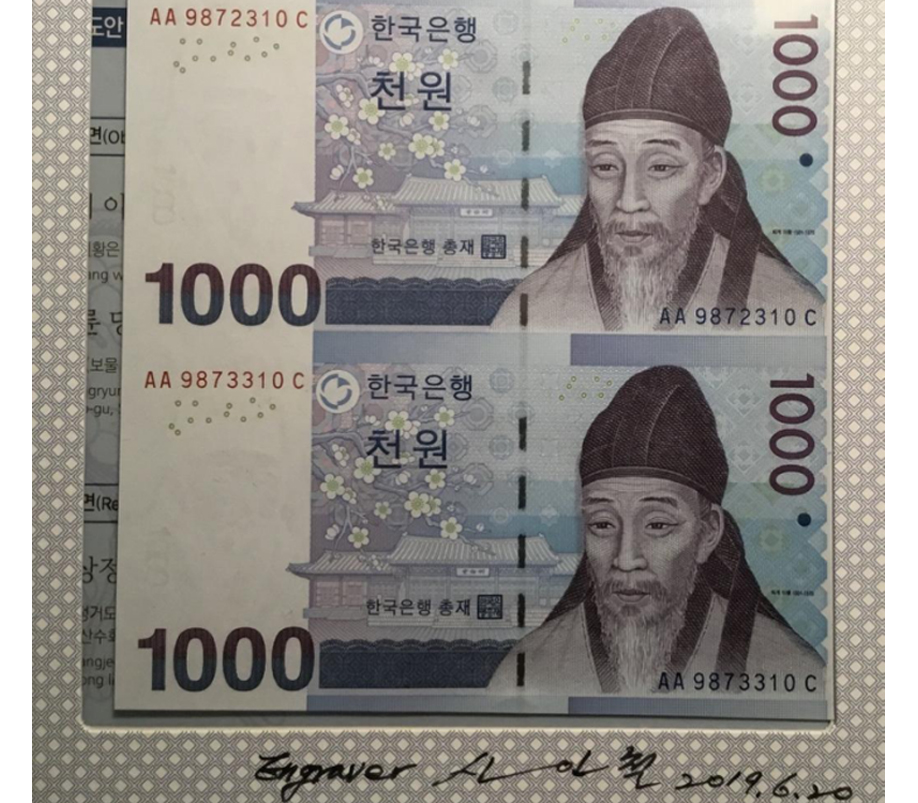 |
|
During my last visit to Korea, I was also gifted this two-note sheet of the 1,000-Won, |
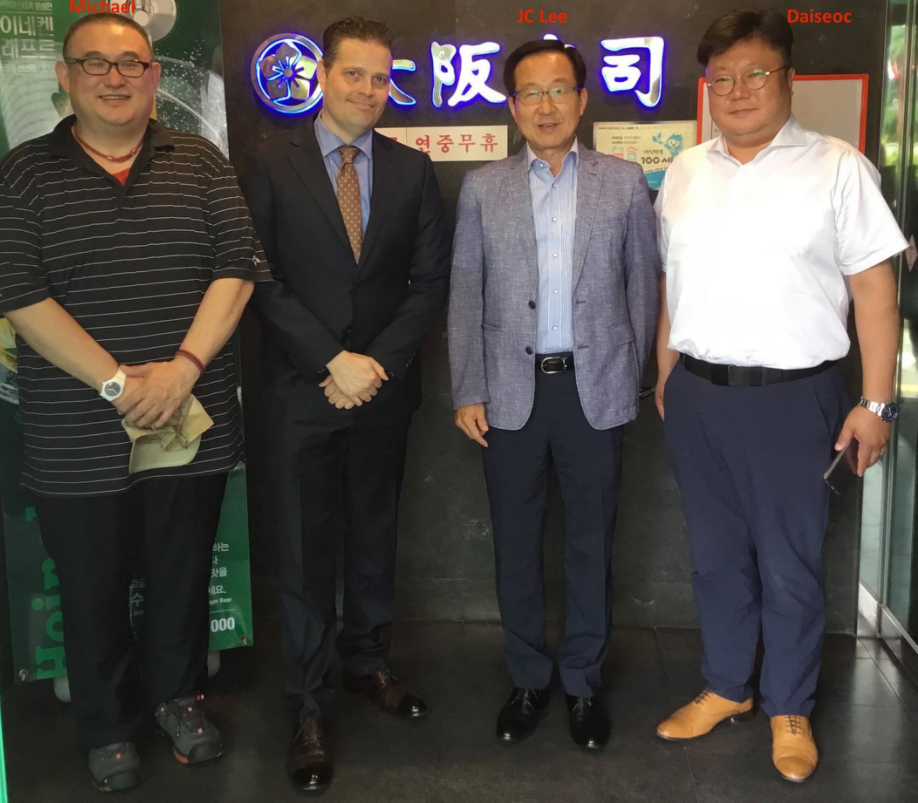 |
|
Michael Chou and I meeting with President J.C. Lee and Daiseoc Cheon of Hwadong. |
Finishing Up
Now that I had these new sources and images to utilize, I went about revising and incorporating these into the mostly-finished chapters for the book. After that, the only thing to do was to write the introductory chapters and consider the style of my writing when editing. As for the style of my writing, I try to remember the advice that fellow Minnesota author F. Scott Fitzgerald gave to his daughter:
"A good style simply doesn't form unless you absorb half a dozen top-flight authors every year. Or rather it forms but instead of being a subconscious amalgam of all that you have admired, it is simply a reflection of the last writer you have read, a watered-down journalese."
My own style seems to find me trying to fit in every fact, figure, and anecdote into my writing, down to the detail of the toenail, although I always end up ruthlessly editing and condensing, which I ended up doing quite a bit for South Korean Coins in the Era of Development. A few of my favorite authors also have writing styles that try to "get everything in". However, I think I mostly met my own personal standards for balancing "information overload" and "just telling the story" in the writing of this book. Another desire was to have at least some of my prose written to poetic standards so that the reader can somewhat enjoy the language of this non-fiction, informational text. Of course, previous authors that I enjoy reading have influenced my writing style, but as Fitzgerald cautioned, I did not want to only reflect the style of the last author that I read, but indeed to create that amalgam of all that I have admired, or better yet, to not worry too much it and just write interestingly enough to engage the reader, but still tell the whole story. I hope readers find my book to be both entertaining and informative.
Looking back on the process of peeling back the layers of discovery and the hard work of writing this book, I can say in all honesty it was a labor of love.
